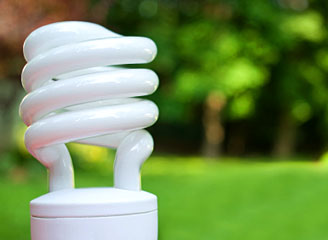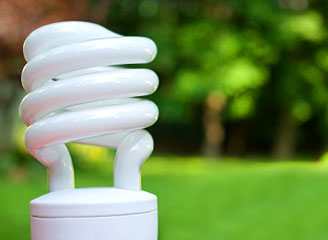The light Compact fluorescent light bulbs — what a bright idea.ing sector is on the edge of a spectacular revolution, a shift from the century-old, inefficient incandescent light bulb to far more efficient technologies. Perhaps the quickest, most profitable way to reduce electricity use worldwide — thus cutting carbon emissions — is simply to change light bulbs.
Compact fluorescent light bulbs — what a bright idea.ing sector is on the edge of a spectacular revolution, a shift from the century-old, inefficient incandescent light bulb to far more efficient technologies. Perhaps the quickest, most profitable way to reduce electricity use worldwide — thus cutting carbon emissions — is simply to change light bulbs.
The first advance in this field came with compact fluorescent lamps (CFLs). Replacing old-fashioned inefficient incandescent bulbs that are still widely used today with new CFLs can reduce the electricity used for lighting by three fourths. Over its lifetime, each standard (13 watt) CFL will reduce electricity bills by roughly $30. And though a CFL may cost twice as much as an incandescent, it lasts 10 times as long. Each one reduces energy use compared with an incandescent by the equivalent of 200 pounds of coal over its lifetime. For perspective, the energy saved by replacing a 100-watt incandescent bulb with an equivalent CFL over its lifetime is sufficient to drive a Toyota Prius hybrid car from New York to San Francisco.
CFL production in China, which accounts for 85 percent of the world total, climbed from 750 million units in 2001 to 3 billion units in 2007. Sales in the United States climbed from 21 million CFLs in 2000 to 397 million in 2007. Of the estimated 4.7 billion light sockets in the United States, close to 1 billion now have CFLs.
The world may be moving toward a political tipping point to replace inefficient light bulbs across the board. In February 2007, Australia announced it would phase out the sale of incandescents by 2010, replacing them with CFLs. Canada soon followed with a 2012 phaseout goal. In early 2009, the European Union (E.U.) approved a phaseout of incandescent bulbs, one that will save the average E.U. consumer 25–50 euros each year.
Brazil, hit by a nationwide electricity shortage in 2000–02, responded with an ambitious program to replace incandescents with CFLs. As a result, an estimated half of the light sockets there now contain these efficient bulbs. In 2007, China — working with the Global Environment Facility — announced a plan to replace all its incandescents with more-efficient lighting within a decade.
Retailers are joining the switch too. Wal-Mart, the world’s largest retailer, began an ambitious marketing campaign in 2007 to boost its cumulative U.S. sales of compact fluorescents to over 260 million. Currys, Britain’s largest electrical retail chain, went further — discontinuing sales of incandescent light bulbs in 2007.
CFLs contain a small amount of mercury (about one fifth the quantity in a watch battery), but they can be safely recycled at the end of their useful lives. Burning the coal needed to power one incandescent light bulb releases much more mercury into the atmosphere — and eventually the water and food supply — than the amount contained in a CFL.
For office buildings, commercial outlets, and factories, where linear (tubular) fluorescents are widely used, the key to cutting electricity use is shifting to the most advanced models, which are even more efficient than CFLs. The potential savings are large; since linear fluorescents are long-lasting, many of those now in use rely on an earlier, less energy-efficient technology.
The second major advance in lighting technology is the light-emitting diode (LED), which uses up to 85 percent less electricity than an incandescent bulb. Although LEDs are the ultimate in lighting efficiency, they are still too costly for most uses. They are rapidly taking over several niche markets, however, such as traffic lights, where they now have 52 percent of the U.S. market, and exit signs in buildings, where they hold 88 percent of U.S. sales. New York City has replaced traditional bulbs with LEDs in many of its traffic lights, cutting its annual bill for maintenance and electricity by $6 million. In early 2009, Los Angeles Mayor Antonio Villaraigosa said the city would replace its 140,000 street lights with LEDs, saving taxpayers $48 million over the next seven years. The resulting reduction in carbon emissions would be like taking 7,000 cars off the road.
Universities are also getting involved. In California, the University of California-Davis has a Smart Lighting Initiative. One of its first projects was to replace all the light bulbs in a campus parking garage with LEDs, dramatically reducing electricity use. This success has evolved into LED University, a project to disseminate this technology. Early adopters include the University of California-Santa Barbara, Tianjin Polytechnic University in China, and the University of Arkansas.
LEDs offer another strong economic advantage. While CFLs last 10 times as long as incandescents, LEDs last 50 times as long. Indeed, a typical LED installed at the time of a child’s birth will still be working when the youngster graduates from college. The savings in commercial situations from both lower electricity costs and the virtual elimination of replacement maintenance often more than offsets the higher initial cost.
In addition to switching bulbs, energy can be saved just by turning lights off when they are not in use. There are numerous technologies for doing this, including motion sensors that turn lights off in unoccupied offices, living rooms, washrooms, hallways, and stairwells. Sensors and dimmers can also be used to take advantage of daylighting to reduce the intensity of interior lighting when sunlight is bright. In cities, dimmers can be used to reduce streetlight intensity. In fact, these smart lighting technologies can cut the electricity use of LEDs to less than 10 percent that of incandescents.
In summary, shifting to CFLs in homes, to the most advanced linear fluorescents in office buildings, commercial outlets, and factories, and to LEDs in traffic lights would cut the world share of electricity used for lighting from 19 percent to 7 percent. This would save enough electricity to close 705 of the world’s 2,670 coal-fired plants. (See data.) If the high cost of LEDs drops faster than we have assumed, making widespread use feasible, lighting efficiency gains will come even faster than we have projected.
In a world facing almost daily new evidence of climate change and its consequences, a quick and decisive victory is needed in the battle to cut carbon emissions and stabilize climate. A rapid shift to the most energy-efficient lighting technologies would provide just such a victory — generating momentum for even greater advances in climate stabilization.
Adapted from Chapter 4, “Stabilizing Climate: An Energy Efficiency Revolution” in Lester R. Brown, Plan B 4.0: Mobilizing to Save Civilization (New York: W.W. Norton & Company, 2009), available online.


